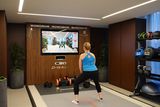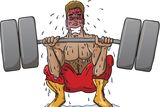Why we're swapping Zumba for retro running
Retro running is great for the 'glutes'
The hottest new fitness trend just so happens to be one that can save you time and money.
Tired of Zumba and done with Pilates? You could try Backwards (or Barefoot) Running, Dog Yoga, or online Fitness Gaming. The latest workout trends range from the extreme to the extremely strange, with Backwards or "Retro" Running (great for the glutes, apparently) proving to be a hit in Japan and parts of Europe.
The results of a new survey suggest that this year we'll be swapping our Zumba workouts for Body Weight Training (BWT)and HIIT - or High Intensity Interval Training. Our aim will be to push ourselves as hard as we can in the shortest time available for maximum results.
The ninth annual survey of 3,400 health and fitness professionals worldwide by the American College of Sports Medicine (ACSM) has predicted a big move towards BWT and HITT in 2015 - even if some older methods will endure.
The Wild Atlantic Way is up and running as the world's longest defined coastal touring route
Yoga is still the most popular speciality class, with Bikram (26 spine-tangling postures performed over 90 minutes in a super-heated room) still the choice of hard-core fans.
But Zumba, recently the most popular fitness class, has suddently become seriously passé. The dance fitness program created by Colombian dancer Alberto "Beto" Perez during the 90s was number No 9 in ACSM's survey in 2012. But it fell to 34th in 2014.
Body Weight Training - one of the current hottest trends - offers the twin benefits of rapid results and low-cost. BWT is basically resistance training, using your own weight, rather than barbells, kettlebells or exercise machines, to build muscle and burn calories.
High Intensity Interval Training (HIIT) involves short bursts - as little as 20 seconds of intense activity, followed by equally brief periods of rest.
Five or 10km running events are primarily aerobic in nature
Multiple studies have shown that you can burn more fat and build more muscle in the half hour or less it takes to perform a typical HIIT routine than you can in an hour or more of conventional aerobic or resistance training.
Fergal Fitzmaurice is an Irish personal trainer who works with clients (including celebrities) in London and Manchester. He says that the core values behind HIIT are actually rooted in decades gone by.
"Top-level athletes have been doing interval training since the '40s or '50s, it's just now that it's gone really mainstream. And there are loads of variations of it.
"With HIIT, you can compress your workout down to 30 minutes. Also, multiple studies have shown that intense, interval workouts raise your metabolism rate to where you are still burning calories after you have left the gym, sometimes for hours.
"You really can get fantastic results but it's very high impact, you cannot just go from zero to 100 miles an hour without carefully warming up first and getting the movement right.
"You can get amazing results - but you can also get amazingly injured. Get it wrong and you will be going from the gym to a chiropractor."
Another increasing popular trend is Tabata, which is relatively easy to master and do in your own home. A typical routine consists of a five-minute warm-up, a four-minute all-out cycle, two minutes of rest, followed by another four-minute cycle with a different exercise, and a five-minute cool down.
Just these short bursts have been shown to increase VO2 max (maximal aerobic capacity) as much as if you did 45 minutes of long, slow cardio. And while it may not get you the kind of dramatic results making report from doing HIIT, it may be easier to integrate into your daily routine in the long run.
Join the Irish Independent WhatsApp channel
Stay up to date with all the latest news















